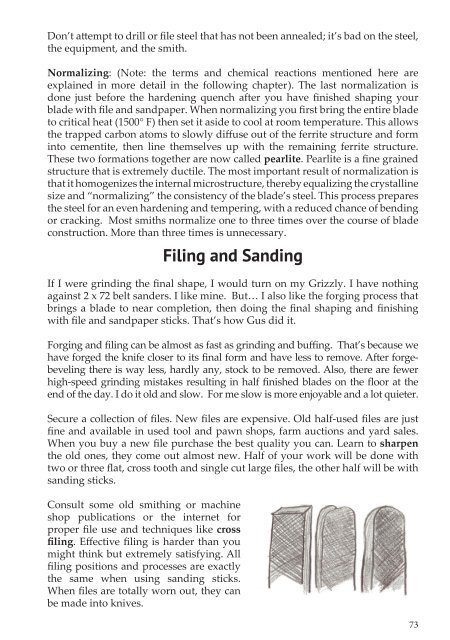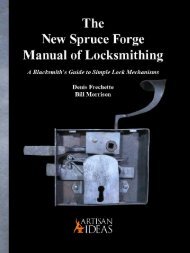FORGED: Making a Knife with Traditional Blacksmith Skills
This book will teach you to hand build a knife using the traditional method of blacksmiths of old — FORGING. Traditional forging of a knife blade is a process which uses the ancient techniques of moving hot steel with hammer and anvil alone into a knife-form that is ready for filing, heat treating and sharpening with no or very minimal electric grinding. This book also teaches traditional fit-and-finish skills using only hand tools. It explains an ancient riveted full-tang handle construction system that surpasses modern methods. In the author's words; "In my early blacksmithing years, I was lucky to get to know some old smiths who wrangled hot iron every day just to make a living. They unselfishly taught me traditional blacksmithing skills and knife forging methods. Every time I use those skills and methods, I honor their friendships, and by teaching you, the reader, we keep alive the memory of those old-time iron pounders." Hardcover, 132 pages, 150 photos and illustrations, $29.95.
This book will teach you to hand build a knife using the traditional method of blacksmiths of old — FORGING.
Traditional forging of a knife blade is a process which uses the ancient techniques of moving hot steel with hammer and anvil alone into a knife-form that is ready for filing, heat treating and sharpening with no or very minimal electric grinding.
This book also teaches traditional fit-and-finish skills using only hand tools. It explains an ancient riveted full-tang handle construction system that surpasses modern methods.
In the author's words; "In my early blacksmithing years, I was lucky to get to know some old smiths who wrangled hot iron every day just to make a living. They unselfishly taught me traditional blacksmithing skills and knife forging methods. Every time I use those skills and methods, I honor their friendships, and by teaching you, the reader, we keep alive the memory of those old-time iron pounders."
Hardcover, 132 pages, 150 photos and illustrations, $29.95.
Create successful ePaper yourself
Turn your PDF publications into a flip-book with our unique Google optimized e-Paper software.
Don’t attempt to drill or file steel that has not been annealed; it’s bad on the steel,<br />
the equipment, and the smith.<br />
Normalizing: (Note: the terms and chemical reactions mentioned here are<br />
explained in more detail in the following chapter). The last normalization is<br />
done just before the hardening quench after you have finished shaping your<br />
blade <strong>with</strong> file and sandpaper. When normalizing you first bring the entire blade<br />
to critical heat (1500° F) then set it aside to cool at room temperature. This allows<br />
the trapped carbon atoms to slowly diffuse out of the ferrite structure and form<br />
into cementite, then line themselves up <strong>with</strong> the remaining ferrite structure.<br />
These two formations together are now called pearlite. Pearlite is a fine grained<br />
structure that is extremely ductile. The most important result of normalization is<br />
that it homogenizes the internal microstructure, thereby equalizing the crystalline<br />
size and “normalizing” the consistency of the blade’s steel. This process prepares<br />
the steel for an even hardening and tempering, <strong>with</strong> a reduced chance of bending<br />
or cracking. Most smiths normalize one to three times over the course of blade<br />
construction. More than three times is unnecessary.<br />
Filing and Sanding<br />
If I were grinding the final shape, I would turn on my Grizzly. I have nothing<br />
against 2 x 72 belt sanders. I like mine. But… I also like the forging process that<br />
brings a blade to near completion, then doing the final shaping and finishing<br />
<strong>with</strong> file and sandpaper sticks. That’s how Gus did it.<br />
Forging and filing can be almost as fast as grinding and buffing. That’s because we<br />
have forged the knife closer to its final form and have less to remove. After forgebeveling<br />
there is way less, hardly any, stock to be removed. Also, there are fewer<br />
high-speed grinding mistakes resulting in half finished blades on the floor at the<br />
end of the day. I do it old and slow. For me slow is more enjoyable and a lot quieter.<br />
Secure a collection of files. New files are expensive. Old half-used files are just<br />
fine and available in used tool and pawn shops, farm auctions and yard sales.<br />
When you buy a new file purchase the best quality you can. Learn to sharpen<br />
the old ones, they come out almost new. Half of your work will be done <strong>with</strong><br />
two or three flat, cross tooth and single cut large files, the other half will be <strong>with</strong><br />
sanding sticks.<br />
Consult some old smithing or machine<br />
shop publications or the internet for<br />
proper file use and techniques like cross<br />
filing. Effective filing is harder than you<br />
might think but extremely satisfying. All<br />
filing positions and processes are exactly<br />
the same when using sanding sticks.<br />
When files are totally worn out, they can<br />
be made into knives.<br />
73










